This post was contributed by our buddy and Andy Blow from Precision Hydration. He has a few top 10 Ironman and 70.3 finishes and an Xterra World Age Group title to his name. He founded Precision Hydration to help athletes solve their hydration issues. He has a degree in Sport and Exercise Science and was once the Team Sports Scientist for Benetton and Renault F1 teams.

A Short History of Sports Drinks (And the Science Behind Them)
The quick history lesson.
Way back in 1909 James E. Sullivan, the Head honcho at the US Amateur Athletic Union, advised that athletes “Don’t get in to the habit of drinking and eating in a marathon race; some prominent runners do, but it is not beneficial” . Sitting here just over a century later, it’s difficult not to have a bit of a laugh at this but, remarkably, it’s fair to say that his sweeping statement was the prevailing wisdom at the time. ‘Nil by mouth’ was considered to be the best approach for athletes during training and competition.
In these (somewhat) more enlightened times, we take it for granted that consuming specific nutrients before, during and after exercise can boost performance and recovery. We also have a huge range of purpose made sports nutrition products at our fingertips to deliver those nutrients (some of which are of dubious value I should add). A combination of knowledge and the availability of convenient (and portable) products is a major advantage to modern athletes. But the industry we now take for granted had quite interesting beginnings…

As fluorescent as the drink itself…
‘Glucozade’ (shortened to the catchier “Lucozade’ pretty early on) can justifiably lay claim to being the earliest traceable ancestor of the multi-billion dollar sports drink industry as it launched in 1927. It was devised by a chemist called William Owen as a way of delivering quick, digestible energy and fluids to anyone made sick by a host of common illnesses.
Although the idea was at heart very simple – basically it was citrus flavoured sugar water – Lucozade was a big hit and the Beecham Company (who merged with SmithKline many years later) acquired the brand in 1938. With the help of some memorable marketing campaigns, by the 1950s Lucozade was contributing over 50% of the profits on Beecham’s bottom line and had cemented itself as one of Britain’s best known brands.
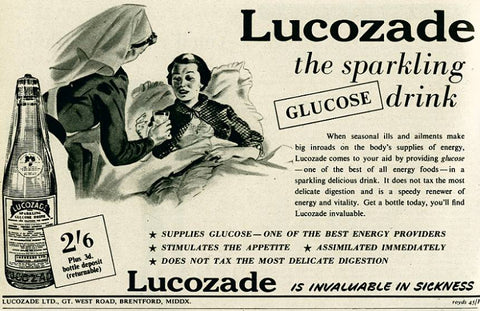
You heard it here first, it “does not tax the most delicate digestion”…
Despite all of this early success as a ‘medicinal’ product, Lucozade initially missed the boat when it came to the emerging sports drink market. With it’s commercial launch in 1967, that other famous ’ade’ – Gatorade – effectively created (and then dominated) the new sports drinks niche. Lucozade didn’t launch it’s own ‘Sport’ branded products until as late as the 1980s! Like Lucozade, Gatorade has a somewhat medical background as it was created off the back of work done by a physician by the name of Robert Cade (that’s him at the top of this post).
What started as a kidney specialist and football coach’s efforts to stop the Florida University football players flaking out in the summer heat ended up as one of the most recognisable brands in sport and the rise of the era of the ‘performance enhancing beverage’.
This early start has helped Gatorade remain the main player in the market today with an estimated 69.5% market share in the USA alone (2013 data from marketrealist.com).
What’s worth noting is just how recently the lion’s share of progress in the field of sports nutrition has occurred. The sports drinks business only really hits the big five-oh next year.

Mmmm, very appetising. It’s in a green can though, so it must be good for you?
What was in those early sports drinks?
Early Gatorade was very different from the original Lucozade. Dr Cade used his medical knowledge to come up with a simple but effective formulation, using specific doses of sugar and salt mixed into water to replace the energy being burned and what was being lost in sweat. Lucozade was much higher in sugar, with negligible salt content, as it was just aiming to restore ‘energy’ to those who drank it.
Legend has it that the very first Gatorade formulation literally contained only sugar and salts dissolved in water, but that due to its nasty taste Mrs Cade suggested he add lemon juice to the mix in order to convince the athletes to drink the stuff. This stroke of culinary genius apparently made all the difference and the idea of a fruit-flavoured, electrolyte and sugar based sports drink started to really take off.
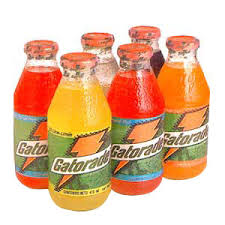
It’s not colours and flavours that matter but key amounts of core ingredients and personalising to the individual’s needs.
What do sports drinks actually do?
Today you can get thousands of different sports drinks containing all manor of things. But what are they actually good for?
Well, your body burns energy when you’re exercising because of the work involved in contracting your muscles and it also loses water and electrolytes (mainly sodium) through sweat. Whilst you have stores of all of these things, all three do need replacing if you exercise reasonably intensively for long enough.
Water, sodium and calories (in different proportions) are the three main things you need to keep the body going during prolonged activity. These are the bottom line ingredients a sports drink has to contain to address your body’s needs when you’re working hard and sweating. Most other things are just fluff. There are some drinks containing additives with proven performance benefits, like caffeine, that can be somewhat useful as well, but at the core of it a sports drink is really just a delivery mechanism for water, salt and sugar.
Although the exact composition varies slightly from brand to brand, all of the major ‘ades’ (Gator, Power and Lucoz) offer a ‘one size fits all’ solution of approximately 6% carbohydrate and between 400-500mg of sodium per litre, flavoured to make them palatable (and as Mrs Cade knew all too well, palatability matters when it comes to selling beverages).
Interestingly, this ‘industry standard’ is supposedly quite a bit more sugary and less salty than the very first iterations of Gatorade that Robert Cade mixed up in his kitchen; perhaps catering more to taste and carbohydrate fuelling needs than maximising their ability to hydrate. This is especially interesting given the direction in which many sports drinks recipes are moving these days.
These drinks are generally termed ‘isotonic’ because they contain a similar amount of molecules to the body’s own fluids (in the region of 285-295 milli-osmoles per kilogram), meaning they’re a similar ‘thickness’ to your blood. As a result, they move across the gut wall into the blood stream at a fairly decent rate.
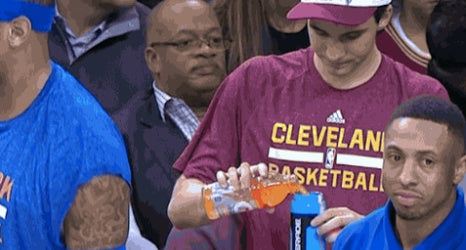
Gatorade and Powerade. Different bottles but the same one-size-fits-all approach…
A good way to think of these industry standard isotonic formulations is that they are designed to be a Jack of all trades. They aim to balance the delivery of digestible carbohydrate energy, some electrolytes and fluids to meet all of the main requirements of an exercising body.
To that end they can work pretty well in certain circumstances, for some people. However, this means that they are in fact the masters of no particular function. Despite their apparent versatility, they neither deliver energy nor fluids and electrolytes as effectively as products designed specifically to do one or the other.
They also fail to take into account the fact that calorie, fluid and electrolyte requirements are not synchronised. People’s physiology, exercise habits and confounding factors (like the weather) all vary. This means that a single product with a set composition is sadly never going to work for all people, in all scenarios.

Our research clearly shows that a one-size-fits-all approach just isn’t acceptable when it comes to hydration.
The problem with traditional sports drinks.
So, whilst traditional isotonic sports drinks might work fairly well in small amounts and for shorter activities, where they really start to struggle to deliver is in situations where exercise is prolonged, sweat rates are high and/or individual needs for components like sodium are on the higher side.
That’s because, during these longer and sweatier activities, the balance of what your body needs to maintain performance starts to shift away from primarily carbohydrates (as is the case in relatively short, intensive endurance events) towards a greater emphasis on fluids and salts as losses of these finite resources start to mount up over time. This is when serious dehydration or electrolyte depletion becomes more of a threat.
If you’re relying entirely on an isotonic drink to replace fluids and electrolytes and you simply increase your intake to meet your escalating needs when your sweat rate is high, gastro-intestinal distress (a.k.a ‘gut rot’) is often the unfortunate consequence. That’s something that has derailed many endurance athletes to say the least! This ‘digestive unhappiness’ happens because the stomach and intestines get overwhelmed with the high levels of sugar in the drink. Beyond a certain volume, most people will start to feel sick and bloated which is clearly no good for performance.
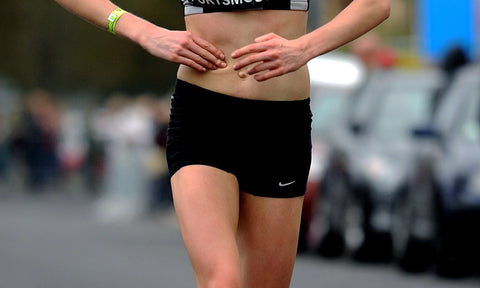
Frequent trips to the Portaloo don’t do wonders for your performance…
To avoid this scenario many athletes learn – often through simple trial and error – to dilute isotonic drinks down with water on hotter days or during longer events, making them hypotonic (i.e. a lower concentration than blood).
This does make them easier to consume in large volumes and so helps to solve the fluid replacement issue to a degree, but it has the unwanted side effect of diluting the already minimal levels of electrolytes found in them down to largely insignificant levels.
And this the reason why a select few modern sports drinks (including our own Precision Hydration range) have moved on to a hypotonic composition. These tend to have lower levels of carbohydrate (around a 3% solution, rather than the 6% solution in isotonic drinks) and much higher electrolyte content.
Whilst the lower level of carbohydrates in the drinks makes them slightly less effective for fuelling, it makes a lot more sense than using isotonic drinks to try to meet all of your needs at once, but not quite fully meeting any of them. Athletes who drink hypotonic drinks meet the lions share of their fuelling needs through consuming solid or semi solid options like gels, energy bars or ‘real’ foods instead, depending on the event.
In other words, by largely separating your fluid/electrolyte replacement needs from your energy requirements, you can dial both in to your individual physiology rather than finding a ‘happy medium’.

Our Sweat Tests enable Personalized Hydration Plans that match how you sweat. BPC has the necessary equipment to administer these Advanced Sweat Tests.
Personalization – the future of sports drinks.
If preventing excessive dehydration is the main role of a sports drink, then there’s a strong case for looking at the substance it is trying to replace – sweat – to help determine the optimal composition.
The interesting thing about sweat is that in one very important component – sodium concentration – it varies dramatically from person to person. Whereas the intracellular electrolytes found in sweat (potassium, calcium and magnesium) tend to be lost in very tiny and consistent amounts in sweat, sodium loss (which is predominant ion in extracellular fluid) can vary 10 fold between individuals. It ranges between around 200 and 2000mg/l in healthy athletes. And, although it’s so variable between one person and the next, sweat sodium concentration remains pretty stable within an individual, so your own sweat composition can be almost permanently categorised as Low, Moderate, High or Very High.
Coupled with differences in sweat rates (driven by genetics, work rate, environmental temperature and so on) and total sweat volume losses, over time sodium output can vary 30 fold between two athletes doing the same activity.
Because sodium plays such a critical role in fluid balance, nerve impulse transmission and muscular contraction, a truly effective sports drink needs to replace it at a level that takes into account this high level of variance in losses from one person to the next.
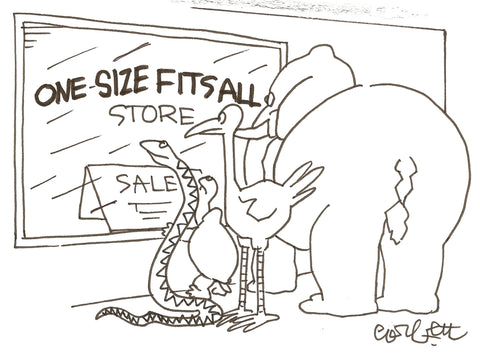
In other words, whilst a ‘one size fits all’ formulation might work for some of the people some of the time, it will never work for all of the people, all of the time. And this is especially true for the ‘outliers’ – those people whose sweat volume and sweat sodium concentrations are either very high or very low – as their needs are not well catered for by a single formulation of drink that aims to hit the middle of the bell curve. And I say ‘outliers’ with quotations because we’ve found that about 20% of the athletes we sweat test have a High or Very High sweat sodium concentration, so it’s not just limited to a few freaks with salty sweat like myself (and Coach Dale)!
Coach Dale Interjection: In our tests of mid-south athletes, we’ve actually seen 30% fall in the HIGH level of salty sweaters. Granted, the fellas at Precision Hydration have done thousands of tests across all sports. Ours have been limited to endurance athletes at this point.
All of which leads us to the point we’re at now with sports drinks starting to become tailored to meet the physiological requirements of the individual athlete. We have a lot to thank the likes of Dr Cade and William Owen for. They helped foster the rise of modern sports nutrition and the industry that helps todays athletes achieve greater and greater things. But, it’s time for the next chapter in the history of the industry. The age of personalization.
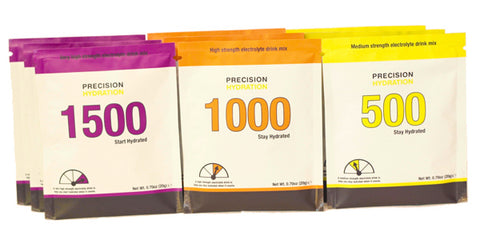
Our new products contain just 8 ingredients and nothing you don’t need. You can get some of this product from the good people at BPC.
At Precision Hydration, we’ve been championing personalized hydration for years now and we’re glad to say it’s really starting to catch on. And now we’re ready to usher in the next phase of evolution in the sports drink market. Our new range of all-natural electrolyte drink mixes still come in multiple strengths, containing 250mg, 500mg, 1000mg and 1500mg of sodium per litre. But now they take advantage of a well-research mechanism called ‘sodium glucose co-transport’ to increase the rate at which fluid enters your body.
They’re also kinder on your stomach and more suitable for drinking when exercising as we now use the alkaline Sodium Citrate instead of Sodium Chloride/Bicarbonate. They come in single-serving waterproof sachets for added convenience, they’re free from any artificial ingredients and they taste better too.
Basically they’re even better than ever at helping you maintain your performance when it matters to you. We hope you’ll give them a try and let us know what you think.
